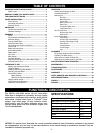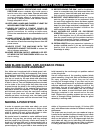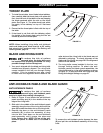
7
KICKBACKS
Kickbacks can cause serious injury. A kickback occurs
when a part of the workpiece binds between the saw
blade and the rip fence, or other fixed object, and
rises from the table and is thrown toward the operator.
Kickbacks can be avoided by attention to the following
conditions.
HOW TO REDUCE THE RISK OF
KICKBACKS AND PROTECT YOURSELF
FROM POSSIBLE INJURY:
• Be certain that the rip fence is parallel to the saw
blade.
• DO NOT rip by applying the feed force to the section
of the workpiece that will become the cut-off (free)
piece. Feed force when ripping should always be
applied between the saw blade and the fence; use a
push stick for narrow work, 6 inches (152 mm) wide or
less.
• Keep saw blade guard, riving knife and anti-
kickback assembly in place and operating properly.
The riving knife must be in alignment with the saw
blade and the anti-kickback assembly must stop
a kickback once it has started. Check their action
before ripping by pushing the wood under the anti-
kickback assembly. The teeth must prevent the
wood from being pulled toward the front of the saw.
If any part of assembly is not operational, return to
the nearest authorized service center for repair.
• Plastic and composite materials (like hardboard) may
be cut on your saw. However, since these are usually
quite hard and slippery, the anti-kickback pawls may
not stop a kickback. Therefore, be especially attentive
to following proper set up and cutting procedures for
ripping.
• Use saw blade guard, anti-kickback pawls, and riving
knife assembly for every possible operation, including
all through-cut sawing.
• Push the workpiece past the saw blade prior to
releasing control.
• NEVER rip a workpiece that is twisted or warped,
or does not have a straight edge to guide along the
fence.
• NEVER saw a large workpiece that cannot be
controlled.
• NEVER use the fence as a guide or length stop when
crosscutting.
• NEVER saw a workpiece with loose knots, flaws, nails
or other foreign objects.
• NEVER rip a workpiece shorter than 10 inches (254
mm).
• NEVER use a dull blade. A dull blade should be
replaced or re-sharpened.
POWER SOURCE
This saw is equipped with a 15-amp motor for use with
a 120-volt, 60-HZ alternating current. It can be re-wired
for use with a 240-volt power source by a qualified
electrician. See instructions below regarding proper
connections for your saw as wired.
For voltage, the wiring in a shop is as important as
the motor’s rating. A line intended only for lights may
not be able to properly carry the current needed for a
power tool motor; wire that is heavy enough for a short
distance may be too light for a greater distance; and a
line that can support one power tool may not be able to
support two or three.
A separate electrical circuit should be used for your
machines. This circuit should not be less than #12
wire and should be protected with a 20-amp time lag
fuse. If an extension cord is used, use only 3-wire
extension cords which have 3-prong grounding-type
plugs and matching receptacle which will accept the
machine’s plug. Before connecting the machine to the
power line, make sure the switch (s) is in the “OFF”
position and be sure that the electric current is of the
same characteristics as indicated on the machine. A
substantial voltage drop will cause a loss of power and
overheat the motor. It may also damage the machine.
DO NOT EXPOSE THE MACHINE TO RAIN OR OPERATE THE MACHINE IN DAMP LOCATIONS.
POWER CONNECTIONS
GROUNDING INSTRUCTIONS
THIS MACHINE MUST BE GROUNDED WHILE IN USE TO PROTECT THE OPERATOR FROM
ELECTRIC SHOCK.
In the event of a malfunction or breakdown, grounding
provides a path of least resistance for electric current
to reduce the risk of electric shock. This machine is
equipped with an electric cord having a grounding
conductor and a grounding plug. The plug must be
plugged into a matching receptacle that is properly
installed and grounded in accordance with all local
codes and ordinances.
Do not modify the plug as provided on your saw
or as rewired by your electrician. If it will not fit the
receptacle, have the proper receptacle installed by a
qualified electrician.
Improper connection of the equipment-grounding
conductor can result in risk of electric shock. The
conductor with insulation having an outer surface that
is green with or without yellow stripes is the grounding
conductor. If repair or replacement of the electric cord
or plug is necessary, do not connect the equipment-
grounding conductor to a live terminal.
TABLE SAW SAFETY RULES (continued)


















